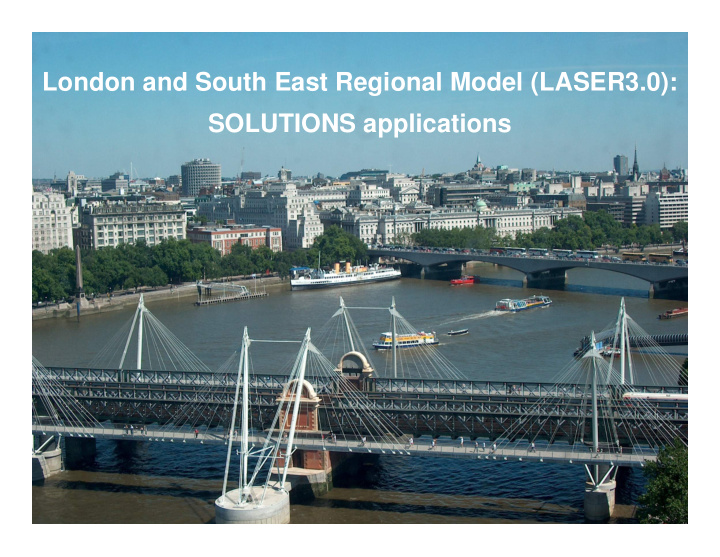



London and South East Regional Model (LASER3.0): SOLUTIONS applications
LASER3.0: Introduction � An integrated land use and model, which WSP Policy & Research developed for DfT � Based on research and modelling since 1988 � MEPLAN software � Covers London, South East and East of England � Model structure dictated by – policy concerns – data availability � WSP’s input to SOLUTIONS funded by DfT/ODPM
Workplace zone Residence zone Non employed households Personal Business travel Home based Children, Adults Census Exogenous Recreation and the elderly household data Commercial travel Employment Housing Housing floorspace By demand Supply Local demand • By industry Education •Income level Education travel • Airports •Car availability Local shopping Retail travel Employed households Census Home based Workforce employed business travel households by • SEG Employed Residents Out Census by commuting employed • Car •SEG residents: SEG availability In commuting •Car availability Census employed residents: car ownership input data Observed data trades / trip matrix Model output LASER3.0 Land Use Model Structure
Commuting to City of London and Westminster: Commuting to City of London and Westminster: (SEG1: Blue; SEG2: Green; SEG3: Brown; SEG4: Red) (SEG1: Blue; SEG2: Green; SEG3: Brown; SEG4: Red)
Mode choice All passenger trips, AM peak ModSplit 100% 90% 80% carMod 70% carObs 60% busMod Split busObs 50% trainMod 40% trainObs slowMod 30% slowObs 20% 10% 0% 1.6 3.2 4.8 8 16 24 40 56 80 160 320 320+ DistBand
Summary Suitable for � Longer term responses � Choice between all passenger modes � Trip lengthening over time � User pricing policies � Congestion and traffic that is choked off � Impacts of land use policy Limitations � AM peak only (7-10am) � Short term local accuracy � Matching individual link loads � Representation of individual bus services
Recommend
More recommend